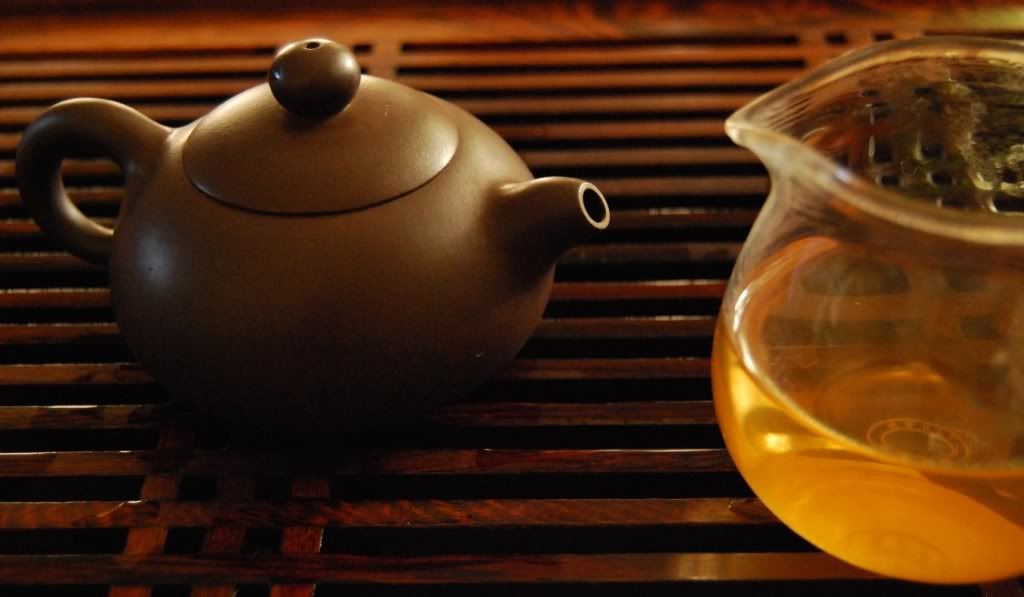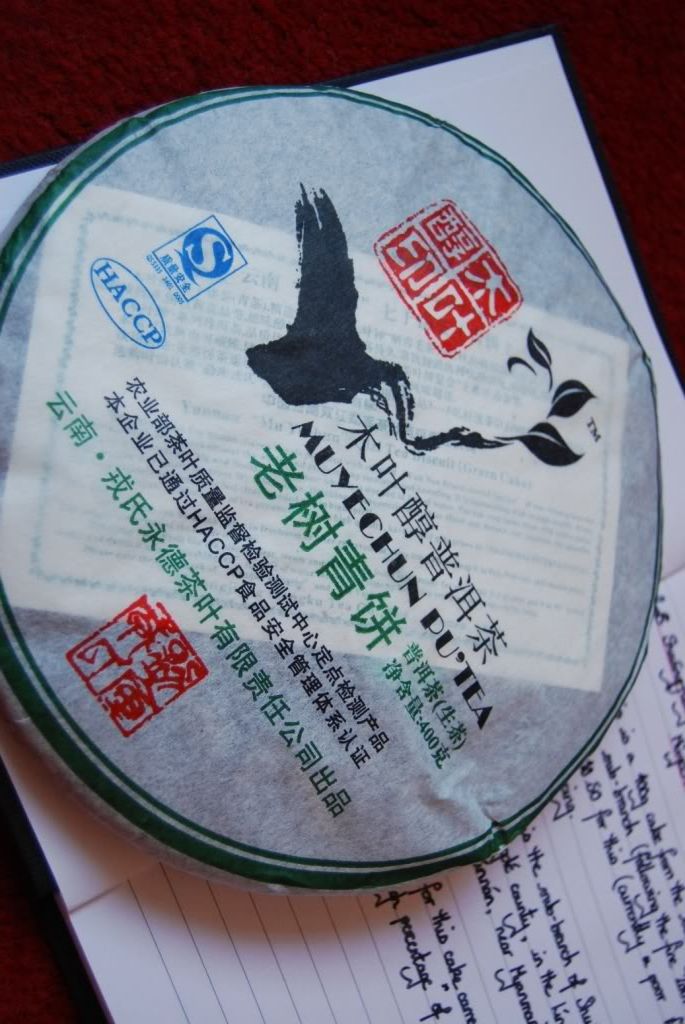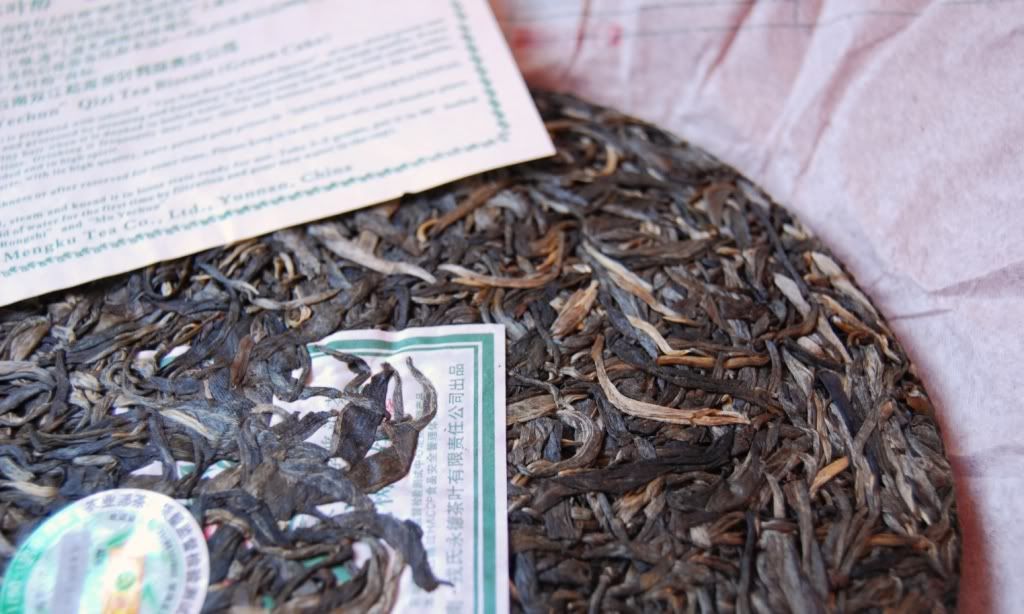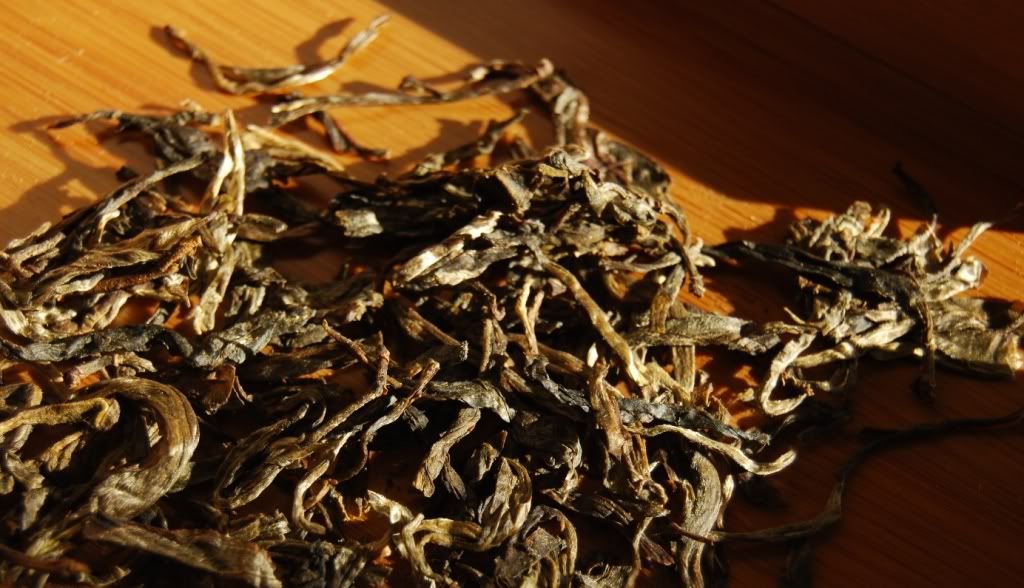One more for the Muyechun book, the first of their 2008 teas that I've tried. It's so cold, this had better not be one of those "cooling sensation" numbers...
This tea is highly inexpensive. I do wonder if Shuangjiang Mengku could do with putting out the odd "premium" cake, but this laoshu-style [old tree] cake is about all they do. You will remember the 001 and 002 from last year, and both ST and Yunnan Sourcing have referred to a mysterious "003" production that I have not yet seen.
Below, the now-familiar pretty branch that signifies the Muyechun output.
Below, the now-familiar pretty branch that signifies the Muyechun output.
Leaves for this tea came from the first flush of 2008, from the Yongde region in which the Muyechun factory is situated, with a "high percentage" of laoshu leaves.
Curiously, the accompanying ticket invites us to steam it apart:
"Shell the tea biscuit first,
steam and knead it in a loose state ready for use."
steam and knead it in a loose state ready for use."
I won't be doing that, but it's an interesting idea. Given the loose compression, it doesn't seem entirely necessary. Shown above, a chubby 400g bing with large leaves of all colours. The aroms is quiet, but is sweet and pleasant - green, candied, with a little spiciness. Reticent, you might say, if feeling kind. Underpowered, if feeling less charitable.
Zounds and gadzooks.
This is a sweet one. I shouldn't be surprised, given the ludicrously sweet 2007 teas from the same producer, but it is quite something. The aroma in the wenxiangbei is white sugar, then, instantaneously, sugary darkness - as if a switch had been thrown. It is a highly acrobatic aroma.
This is a sweet one. I shouldn't be surprised, given the ludicrously sweet 2007 teas from the same producer, but it is quite something. The aroma in the wenxiangbei is white sugar, then, instantaneously, sugary darkness - as if a switch had been thrown. It is a highly acrobatic aroma.
While "low" in the pitch of its flavour, it is reasonably smooth. The first infusions are understated in texture, flavour, and huigan, but this develops satisfactorily by the third brewing.
Creamy and sweet, in correspondence with its tippiness, I rather like it.

Unlike the vapidity of, for example, dancong, this is a conversation with an amiable sort with a good sense of humour. It keeps me entertained, and isn't something from which I'd require too much.
Perhaps, if I were looking for stable tea for immediate consumption, I might buy more of this. However, while pleasant, it doesn't thrill me with possibilities for the future, and I am fortunate to have more than enough tea for immediate drinking. One cake is definitely enough.
Perhaps, if I were looking for stable tea for immediate consumption, I might buy more of this. However, while pleasant, it doesn't thrill me with possibilities for the future, and I am fortunate to have more than enough tea for immediate drinking. One cake is definitely enough.
Addendum
April, 2014
This was inexpensive in 2008, and I found it to be particularly sweet. The maocha comes from the Yongde region. The leaves are quite large, giving the cake a pleasant appearance. They have a sweet and humid scent that gives me hope.
The rinse has the sweet, "dry" scent of other cakes from Lincang diqu. In 2008, I questioned the aging potential of such a sweet cake; six years later, I may now test that assertion.
The wenxiangbei has a big, husky, and fruity aroma. There is a strong component of "purple" sweetness in the main body of this tea, but there is, happily, a solid Lincang base of grain. Muyechun is always accessible, and it seems that this cake is another attempt to dress up "real" pu'ercha with lighter components. It is quite strong, but has not aged quickly: the soup is yellow-orange. By the third infusion, the purple sweetness has faded and we are left with straightforward, and rather basic, Lincang tea.
The rinse has the sweet, "dry" scent of other cakes from Lincang diqu. In 2008, I questioned the aging potential of such a sweet cake; six years later, I may now test that assertion.
The wenxiangbei has a big, husky, and fruity aroma. There is a strong component of "purple" sweetness in the main body of this tea, but there is, happily, a solid Lincang base of grain. Muyechun is always accessible, and it seems that this cake is another attempt to dress up "real" pu'ercha with lighter components. It is quite strong, but has not aged quickly: the soup is yellow-orange. By the third infusion, the purple sweetness has faded and we are left with straightforward, and rather basic, Lincang tea.





Thanks for the nice writeup. I am relatively new to the pu-erh world. I would be interested in knowing what you look for in a tea that "thrills you with the possibilities for the future."
ReplyDeleteDear Stephen,
ReplyDeleteNice poodle photo you've got there!
For aging, something with guts. Something complex, beefy, interesting, challenging, with lots of content. Something thick, energetic, enduring.
That sort of thing. :)
Toodlepip,
Hobbes
Hi Hobbes,
ReplyDeleteSurprised that you only squeezed out the sweet of the tea. Here, I was actually able to get some spiciness and even had some camphor coming through. Flavor was rather complex. I need to qualify that I used a gaiwan, more leaves and hotter water.
BTW, I found out that because of the altitude difference between Singapore and Kunming, the water boils at different temperature. Hence the water here in Singapore is hotter and can knock more flavor out of the same tea. :)
--ST
Dear Seb,
ReplyDeleteCamphor is worth pursuing - I'll give it another look. For some reason I have two samples of this. :)
Brewing water up a mountain makes for some flat tea, I agree! I had a similar experience up "Big Sky" mountain in Montana. That's the beauty of living in the Low Counties...
Toodlepip,
Hobbes